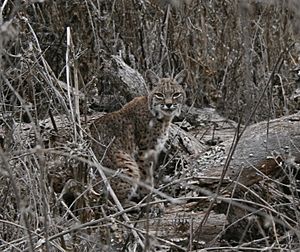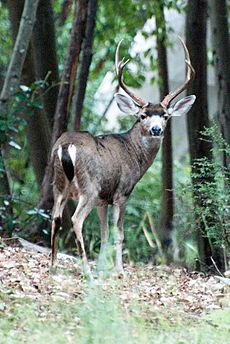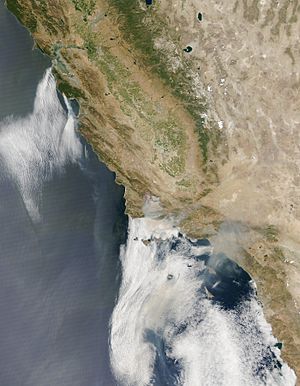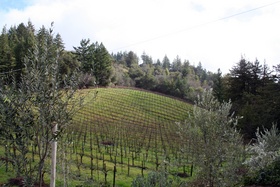Santa Cruz Mountains facts for kids
Quick facts for kids Santa Cruz Mountains |
|
|---|---|
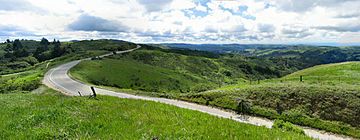
Skyline Boulevard runs through the Santa Cruz Mountains, here in Portola Valley.
|
|
| Highest point | |
| Peak | Loma Prieta Peak |
| Elevation | 3,786 ft (1,154 m) |
| Geography | |
| Country | United States |
| State | California |
| Range coordinates | 37°7′N 121°51′W / 37.117°N 121.850°W |
| Parent range | Pacific Coast Ranges |
The Santa Cruz Mountains are a beautiful mountain range in California, United States. They are part of the larger Pacific Coast Ranges. These mountains form a long ridge south of San Francisco.
They act like a natural wall, separating the cool Pacific Ocean from the warmer San Francisco Bay and the Santa Clara Valley. The mountains stretch south towards Monterey Bay and end near the Salinas Valley. You can find parts of these mountains in five different counties: San Mateo, Santa Clara, Santa Cruz, San Benito, and Monterey. The Pajaro River forms their southern edge.
The Santa Cruz Mountains have different names for different parts. The northern part, near Half Moon Bay, is called Montara Mountain. The middle section is known as the Sierra Morena. South of a gap at Lexington Reservoir, the range is called the Sierra Azul.
Contents
Tallest Peaks and Famous Faults
The highest point in the Santa Cruz Mountains is Loma Prieta Peak. It stands tall at about 3,786 feet (1,154 meters). This peak is famous because it was near the center of a big earthquake in 1989.
Other important peaks include:
- Mount Umunhum at 3,486 feet (1,063 meters)
- Mount Thayer at 3,479 feet (1,060 meters)
- Mount Bielawski at 3,231 feet (985 meters)
- El Sombroso at 2,999 feet (914 meters)
- Black Mountain at 2,800 feet (853 meters)
The famous San Andreas Fault runs right along or very close to the mountain ridge. This fault is where two large pieces of the Earth's crust meet and move. The eastern side of the mountains drops sharply towards this fault line, especially near towns like Woodside and Saratoga.
Getting Around the Mountains
A scenic road called State Route 35, also known as "Skyline Boulevard", runs along the top of the mountains for much of the San Francisco Peninsula. Another major highway, Interstate 280, runs parallel to the mountains on their eastern side.
Many roads cross the mountains, connecting the coast to the inland areas. Some of these include:
- SR 92 from Half Moon Bay to San Mateo
- SR 84 from San Gregorio to Redwood City
- SR 9 from Santa Cruz to Saratoga
- SR 17 from Santa Cruz to Los Gatos
- SR 152 from Watsonville to Gilroy
Wineries and History
The Santa Cruz Mountains are also known for their many wineries. There are over 30 wineries in this area! People have been making wine here since at least the 1840s. In 1981, the region became a special wine-growing area called an American Viticultural Area (AVA). The wines from the Santa Cruz Mountains gained international fame in 1976 at a competition called the Judgment of Paris.
Geology: How the Mountains Formed
The Santa Cruz Mountains were mostly formed by the movement of the San Andreas Fault. This fault causes the Earth's crust to push together, lifting the land upwards. The mountains are made up of older rocks covered by newer layers of sand and other materials from millions of years ago.
Ecology: Plants and Animals
The Santa Cruz Mountains are home to a huge variety of plants and animals. The area has both cool, wet coastal forests and warm, dry chaparral areas. Much of the mountains are considered a temperate rainforest, which means it gets a lot of rain and has mild temperatures.
Trees and Plants
In the valleys and on slopes facing the ocean, you can find some of the southernmost coast redwoods. These are very tall trees that love moisture. You'll also see coast Douglas-fir trees. Other common trees include:
- Coast live oak
- Pacific madrone
- Pacific wax myrtle
- Big leaf maple
- California bay laurel
- California black oak
There are a few small areas of very old forests, called old-growth forests, in parks like Henry Cowell Redwoods State Park and Portola Redwoods State Park. The largest old-growth redwood forest is in Big Basin Redwoods State Park.
At higher elevations and on sunny slopes, you'll find plants that can handle drier conditions. This type of plant community is called chaparral. It includes plants like:
In spring, the mountains are covered in beautiful wildflowers.
Animals
The Santa Cruz Mountains are a great place for birds, with many different species living here. You can often spot black-tailed deer, which are a type of mule deer. Western gray squirrels, chipmunks, and raccoons are also common.
Sometimes, people see black bears, which might wander north from Big Sur. Other animals that live here but are harder to spot include foxes, coyotes, bobcats, and cougars (also known as mountain lions). You might also see Virginia opossums, which were brought to the area by humans. Rattlesnakes live here too, mostly in the dry chaparral areas.
Climate and Weather
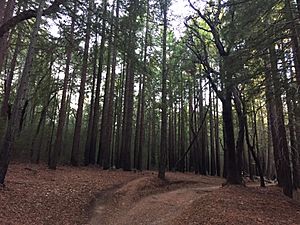
The Santa Cruz Mountains have a Mediterranean type climate. This means they have wet, mild winters and dry, warm summers. Most of the rain falls between November and April. The mountains get a lot of rain, often more than 50 inches (127 cm) each year.
Heavy summer fogs often cover the western slopes that face the ocean. This fog brings moisture to the redwood forests, helping these giant trees to thrive. On the eastern side of the mountains, there is less rain, usually about 25 inches (64 cm) a year. This is because of a "rain shadow" effect, where the mountains block the rain from reaching the other side.
Snow falls a few times a year on the highest parts of the mountains. It's rare for the lower valleys to get snow.
Temperatures in the Santa Cruz Mountains can change a lot between day and night. The difference can be 20-30 degrees Fahrenheit (11-17 degrees Celsius) on average. During heat waves, it can be even more, sometimes up to 50 degrees Fahrenheit (28 degrees Celsius)!
In winter, daytime temperatures are usually in the 50s or low 60s Fahrenheit (10-18 degrees Celsius). Nighttime temperatures can drop to the upper 30s Fahrenheit (3-4 degrees Celsius) in the valleys.
Summers are usually warm, with daytime temperatures often reaching the 80s Fahrenheit (27-32 degrees Celsius). Nights are cooler, usually in the 40s to 60s Fahrenheit (4-18 degrees Celsius). Sometimes, during heat waves, temperatures can get very hot, reaching 95-105 degrees Fahrenheit (35-40 degrees Celsius). These hot, dry conditions can lead to wildfires, like the Loma Fire in 2016 or the Lockheed Fire in 2009.
Recreation and Fun Activities
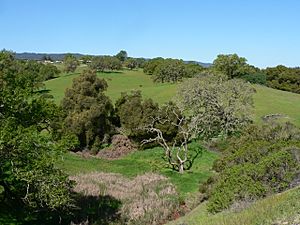
The Santa Cruz Mountains are full of parks and protected natural areas. California's oldest state park, Big Basin Redwoods State Park, is located here.
Other great state parks include:
- Castle Rock State Park
- Portola Redwoods State Park
- Butano State Park
- The Forest of Nisene Marks State Park
- McNee Ranch State Park
- Henry Cowell Redwoods State Park, which has a famous Redwood Grove walking trail.
Many other organizations also help protect land in the mountains, like the Midpeninsula Regional Open Space District.
These parks offer many fun activities:
- Hiking on beautiful trails
- Horse-riding
- Mountain biking
- Rock climbing and bouldering at Castle Rock State Park
- Backpacking and camping in the backcountry
There are also two long-distance trails:
- The Skyline-to-the-Sea Trail is 38 miles (58 km) long. It goes from Castle Rock State Park through Big Basin all the way to the Pacific Ocean.
- The Bay Area Ridge Trail follows the spine of the mountains, offering amazing views.
Cultural History
The Santa Cruz Mountains have a rich history. The old Old Almaden Winery was located on the eastern slopes. It was one of the first places in California to make wine using high-quality European grapes.
Many famous people have lived in the Santa Cruz Mountains:
- The famous film director Alfred Hitchcock and his wife lived near Scotts Valley starting in 1940.
- Science fiction writer Robert A. Heinlein built a home in Bonny Doon in 1965 and lived there for many years.
- Singer-songwriter Neil Young lived at Broken Arrow Ranch near Woodside from 1970 to 2014. He even recorded many of his songs there!
See also
 In Spanish: Montes Santa Cruz para niños
In Spanish: Montes Santa Cruz para niños



